Foliar Silicon Alleviates Water Deficit in Cowpea by Enhancing Nutrient Uptake, Proline Accumulation, and Antioxidant Activity
Abstract
:1. Introduction
2. Results
2.1. Nutrient Accumulation, Proline Content, and Antioxidant Activity
2.2. Growth and Production Components
3. Discussion
4. Materials and Methods
4.1. Location, Treatments, and Statistical Design
4.2. Irrigation Management
4.3. Soil Characteristics and Preparation of Experimental Area
4.4. Experimental Analysis
4.5. Statistical Analysis
5. Conclusions
Author Contributions
Funding
Data Availability Statement
Acknowledgments
Conflicts of Interest
Abbreviations
| APX | Ascorbate peroxidase |
| SOD | Superoxide dismutase |
| CAT | Catalase |
| DF | Degree of freedom |
| CV | Coefficient of variation |
| ETc | Crop evapotranspiration |
| WUE | Water use efficiency |
| SDM | Shoot dry mass |
| NPP | Number of pods per plant |
| MBL | Main branch length |
| CEC | Cation exchange capacity |
| CU | Consumptive use |
| DLD | Daily liquid depth |
| DAS | Days after sowing |
References
- Abebe, B.K.; Alemayehu, M.T. A review of the nutritional use of cowpea (Vigna unguiculata L. Walp) for human and animal diets. J. Agric. Food Res. 2022, 10, 100383. [Google Scholar] [CrossRef]
- Senthilkumar, T.; Ejilane, E.; Ramasamy, M.; Chittibomma, K.; Naorem, C.; Kumar, R.; Prasad, S.V.B.; Dhanalakshmi, K.; Chitra, K. Exploring genetic divergence in cowpea: A comprehensive review. Asian J. Soil Sci. Plant Nutr. 2024, 10, 80–87. [Google Scholar] [CrossRef]
- Omomowo, O.I.; Babalola, O.O. Constraints and prospects of improving cowpea productivity to ensure food, nutritional security and environmental sustainability. Front. Plant Sci. 2021, 12, 751731. [Google Scholar] [CrossRef] [PubMed]
- Silva, J.D.A.; Barros, J.R.A.; Silva, E.G.F.; Rocha, M.D.M.; Angelotti, F. Cowpea: Prospecting for heat-tolerant genotypes. Agronomy 2024, 14, 1969. [Google Scholar] [CrossRef]
- CONAB—Companhia Nacional de Abastecimento. Acompanhamento da Safra Brasileira de Grãos; CONAB: Russas, Brazil, 2024. Available online: https://www.conab.gov.br/info-agro/safras/graos/boletim-da-safra-de-graos (accessed on 6 January 2025).
- Melo, A.S.D.; Melo, Y.L.; Lacerda, C.F.D.; Viégas, P.R.; Ferraz, R.L.D.S.; Gheyi, H.R. Water restriction in cowpea plants [Vigna unguiculata (L.) Walp.]: Metabolic changes and tolerance induction. Braz. J. Agric. Environ. Eng. 2022, 26, 190–197. [Google Scholar] [CrossRef]
- Melo, A.S.; Costa, R.R.; Sá, F.V.S.; Dias, G.F.; Alencar, R.S.; Viana, P.M.O.; Peixoto, T.D.C.; Suassuna, J.F.; Brito, M.E.B.; Ferraz, R.L.S.; et al. Modulation of drought-induced stress in cowpea genotypes using exogenous salicylic acid. Plants 2024, 13, 634. [Google Scholar] [CrossRef]
- Cavalcante, I.E.; Alencar, R.S.; Dias, G.F.; Ribeiro, L.D.; Melo, Y.L.; Ferraz, R.L.S.; Costa, P.S.; Viégas, P.R.A.; Almeida, H.A.; Lacerda, C.F.; et al. Water status, cell integrity, and growth of cowpea plants under water restriction and salicylic acid. Braz. J. Agric. Environ. Eng. 2025, 29, e283012. [Google Scholar] [CrossRef]
- Ibrahim, T.A.A.; Abdel-Ati, K.E.S.A.; Khaled, K.A.M.; Azoz, S.N.; Hassan, A.A. Physiological, molecular and anatomical studies on drought tolerance in cowpea. Egypt. J. Soil Sci. 2025, 65, 253–274. [Google Scholar] [CrossRef]
- Mesquita, E.F.; Mesquita, F.O.; Sousa, C.S.; Ferreira, D.S.; Rocha, J.L.A.; Cavalcante, L.F. Water stress mitigation by silicon in sweet-potato. Rev. Ibero-Am. Ciênc. Ambient. 2021, 12, 363–376. [Google Scholar] [CrossRef]
- Alves, J.M.; Lima, A.S.; Figueredo, L.F.; Mesquita, F.O.; Mesquita, E.F.; Bezerra, F.T.C.; Sousa, C.S.; Silva, F.L.; Suassuna, C.F. Nitrogen and silicon application can increase nutrient uptake and fruit quality of Cucurbita pepo L. Water Air Soil Pollut. 2022, 233, 40. [Google Scholar] [CrossRef]
- Irfan, M.; Maqsood, M.A.; Rehman, H.U.; Mahboob, W.; Sarwar, N.; Hafeez, O.B.A.; Hussain, S.; Ercisli, S.; Akhtar, M.; Aziz, T. Silicon nutrition in plants under water-deficit conditions: Overview and prospects. Water 2023, 15, 739. [Google Scholar] [CrossRef]
- Leite, W.S.; Miranda, R.S.; Rocha, M.M.; Dutra, A.F.; Santos, A.S.; Silva, A.C.; Brito, F.M.; Sousa, R.S.; Araújo, A.S.F.; Nascimento, C.W.A.; et al. Silicon alleviates drought damage by increasing antioxidant and photosynthetic performance in cowpea. J. Agron. Crop Sci. 2023, 209, 772–787. [Google Scholar]
- Almeida, C.J.S.; Dantas, J.S.; Mesquita, E.F.; Sousa, C.S.; Soares, V.C.S.; Diniz, J.P.C.; Pereira, R.F.; Lins, L.K.S.; Nogueira, V.F.B.; Silva Filho, I.P. Silicon as a salt stress mitigator in yellow passion fruit seedlings. Agric. Res. Trop. 2024, 54, e80305. [Google Scholar] [CrossRef]
- Mesquita, E.F.; Mesquita, F.O.; Sousa, C.S.; Diniz, J.P.C.; Queiroz, L.L.G.; Soares, V.C.S.; Targino, F.N.; Jales, D.V.D.; Brito Neto, J.F.; Rocha, J.L.A.; et al. Silício e adubação orgânica sobre os atributos físico-químicos de frutos de maracujá-amarelo no semiárido Brasil. Rev. Bras. Geogr. Fis. 2024, 17, 100–116. [Google Scholar] [CrossRef]
- Christian, M.M.; Shimelis, H.; Laing, M.D.; Tsilo, T.J. Association of yield and yield components among selected bread wheat genotypes under silicon fertilisation and drought conditions. J. Agron. Crop Sci. 2025, 211, e70020. [Google Scholar] [CrossRef]
- Laane, H.-M. The effects of foliar sprays with different silicon compounds. Plants 2018, 7, 45. [Google Scholar] [CrossRef] [PubMed]
- Mali, M.; Aery, A.N.C. Silicon effects on nodule growth, dry-matter production, and mineral nutrition of cowpea (Vigna unguiculata). J. Plant Nutr. Soil Sci. 2008, 171, 835–840. [Google Scholar] [CrossRef]
- Pavlovic, J.; Kostic, L.; Bosnic, P.; Kirkby, E.A.; Nikolic, M. Interactions of silicon with essential and beneficial elements in plants. Front. Plant Sci. 2021, 12, 697592. [Google Scholar] [CrossRef]
- Souri, Z.; Khanna, K.; Karimi, N.; Ahmad, P. Silicon and plants: Current knowledge and future prospects. J. Plant Growth Regul. 2021, 40, 906–925. [Google Scholar] [CrossRef]
- Rea, R.S.; Islam, M.R.; Rahman, M.M.; Nath, B.; Mix, K. Growth, nutrient accumulation, and drought tolerance in crop plants with silicon application: A review. Sustainability 2022, 14, 4525. [Google Scholar] [CrossRef]
- Hao, Y.; Yu, Y.; Sun, G.; Gong, X.; Jiang, Y.; Lv, G.; Zhang, Y.; Li, L.; Zhao, Y.; Sun, D.; et al. Effects of multi-walled carbon nanotubes and nano-silica on root development, leaf photosynthesis, active oxygen and nitrogen metabolism in maize. Plants 2023, 12, 1604. [Google Scholar] [CrossRef] [PubMed]
- Kostic, L.; Nikolic, N.; Bosnic, D.; Samardzic, J.; Nikolic, M. Silicon increases phosphorus (P) uptake by wheat under low P acid soil conditions. Plant Soil 2017, 419, 447–455. [Google Scholar] [CrossRef]
- Hmood, W.M.; Ragab, M.E.; Youssef, S.M.; Metwally, A.A. Effect of selenium and silicon foliar applications on the growth and yield of common bean. Egypt. J. Hortic. 2022, 49, 147–158. [Google Scholar] [CrossRef]
- Narwal, R.P.; Kumar, V.; Singh, J.P. Potassium and magnesium relationship in cowpea (Vigna unguiculata (L.) Walp.). Plant Soil 1985, 86, 129–134. [Google Scholar] [CrossRef]
- Chen, D.; Cao, B.; Wang, S.; Liu, P.; Deng, X.; Yin, L.; Zhang, S. Silicon moderated the K deficiency by improving the plant-water status in sorghum. Sci. Rep. 2016, 6, 22882. [Google Scholar] [CrossRef]
- Jam, B.J.; Shekari, F.; Andalibi, B.; Fotovat, R.; Jafarian, V.; Najafi, J.; Uberti, D.; Mastinu, A. Impact of silicon foliar application on the growth and physiological traits of Carthamus tinctorius L. exposed to salt stress. Silicon 2023, 15, 1235–1245. [Google Scholar] [CrossRef]
- Ghosh, U.K.; Islam, M.N.; Siddiqui, M.N.; Cao, X.; Khan, M.A.R. Proline, a multifaceted signalling molecule in plant responses to abiotic stress: Understanding the physiological mechanisms. Plant Biol. 2022, 24, 227–239. [Google Scholar] [CrossRef] [PubMed]
- Zulfiqar, F.; Ashraf, M. Proline alleviates abiotic stress induced oxidative stress in plants. J. Plant Growth Regul. 2023, 42, 4629–4651. [Google Scholar] [CrossRef]
- Yan, S.; Zhan, M.; Liu, Z.; Zhang, X. Insight into the transcriptional regulation of key genes involved in proline metabolism in plants under osmotic stress. Biochimie 2025, 228, 8–14. [Google Scholar] [CrossRef]
- Santos, A.R.; Melo, Y.L.; Oliveira, L.F.; Cavalcante, I.E.; Ferraz, R.L.S.; Sá, F.V.S.; Lacerda, C.F.; Melo, A.S. Exogenous silicon and proline modulate osmoprotection and antioxidant activity in cowpea under drought stress. J. Soil Sci. Plant Nutr. 2022, 22, 1692–1699. [Google Scholar] [CrossRef]
- Silva, D.C.; Melo, A.S.; Melo, Y.L.; Andrade, W.L.; Lima, L.M.; Santos, A.R. Silicon foliar application attenuates the effects of water suppression on cowpea cultivars. Ciênc. Agrotecnol. 2019, 43, e023019. [Google Scholar] [CrossRef]
- Taiz, L.; Zeiger, E.; Møller, I.M.; Murphy, A. Plant Physiology and Development; Artmed: Porto Alegre, Brazil, 2017. (In Portuguese) [Google Scholar]
- Wang, M.; Wang, R.; Mur, L.A.J.; Ruan, J.; Shen, Q.; Guo, S. Functions of silicon in plant drought stress responses. Horticult. Res. 2021, 8, 254. [Google Scholar] [CrossRef] [PubMed]
- Oliveira, B.R.; Leite, W.D.S.; Miranda, R.D.S.; Dutra, A.F.; Okla, M.K.; Alaraidh, I.A.; Lustosa Sobrinho, R.; Luza, M.R.; Zuffo, A.M.; Sousa, R.S.; et al. Optimizing drought-resistant cowpea cultivar selection mediated by silicon supplementation using TOPSIS tool. J. Plant Growth Regul. 2024, 44, 796–805. [Google Scholar] [CrossRef]
- Alvares, C.A.; Stape, J.L.; Sentelhas, P.C.; Gonçalves, J.L.M.; Sparovek, G. Köppen’s climate classification map for Brazil. Meteorologisch 2013, 22, 711–728. [Google Scholar] [CrossRef] [PubMed]
- USDA—United States Department of Agriculture. Keys to Soil Taxonomy; USDA: Washington, DC, USA, 2014. [Google Scholar]
- Cavalcanti, F.D.A.; Santos, J.C.P.; Pereira, J.R.; Leite, J.P.; Silva, M.C.L.; Freire, F.J.; Lima, J.F.V.F. Recomendações de Adubação para o Estado de Pernambuco; IPA: Recife, Brazil, 2008. [Google Scholar]
- Silva, F.C. Manual de Análises Químicas de Solos, Plantas e Fertilizantes, 2nd ed.; Embrapa: Brasília, Brazil, 2009. [Google Scholar]
- Bates, L.S.; Waldren, R.P.; Teare, I.D. Rapid determination of free proline for water-stress studies. Plant Soil 1973, 39, 205–207. [Google Scholar] [CrossRef]
- Bezerra Neto, E.; Barreto, L.P.N. Análises Químicas e Bioquímicas em Plantas, 1st ed.; UFRPE: Recife, Brazil, 2011. [Google Scholar]
- Beauchamp, C.; Fridovich, I. Superoxide dismutase—Improved assays and an assay applicable to acrylamide gels. Anal. Biochem. 1971, 44, 276–287. [Google Scholar] [CrossRef]
- Kar, M.; Mishra, D. Catalase, peroxidase, and polyphenoloxidase activities during rice leaf senescence. Plant Physiol. 1976, 57, 315–319. [Google Scholar] [CrossRef]
- Nakano, Y.; Asada, K. Hydrogen peroxide is scavenged by ascorbate-specific peroxidases in spinach chloroplast. Plant Cell Physiol. 1981, 22, 867–880. [Google Scholar]
- Souza, L.S.B.; Moura, M.S.B.; Sediyama, G.C.; Silva, T.G.F. Eficiência do uso da água das culturas do milho e do feijão-caupi sob sistemas de plantio exclusivo e consorciado no semiárido brasileiro. Bragantia 2011, 70, 715–721. [Google Scholar] [CrossRef]

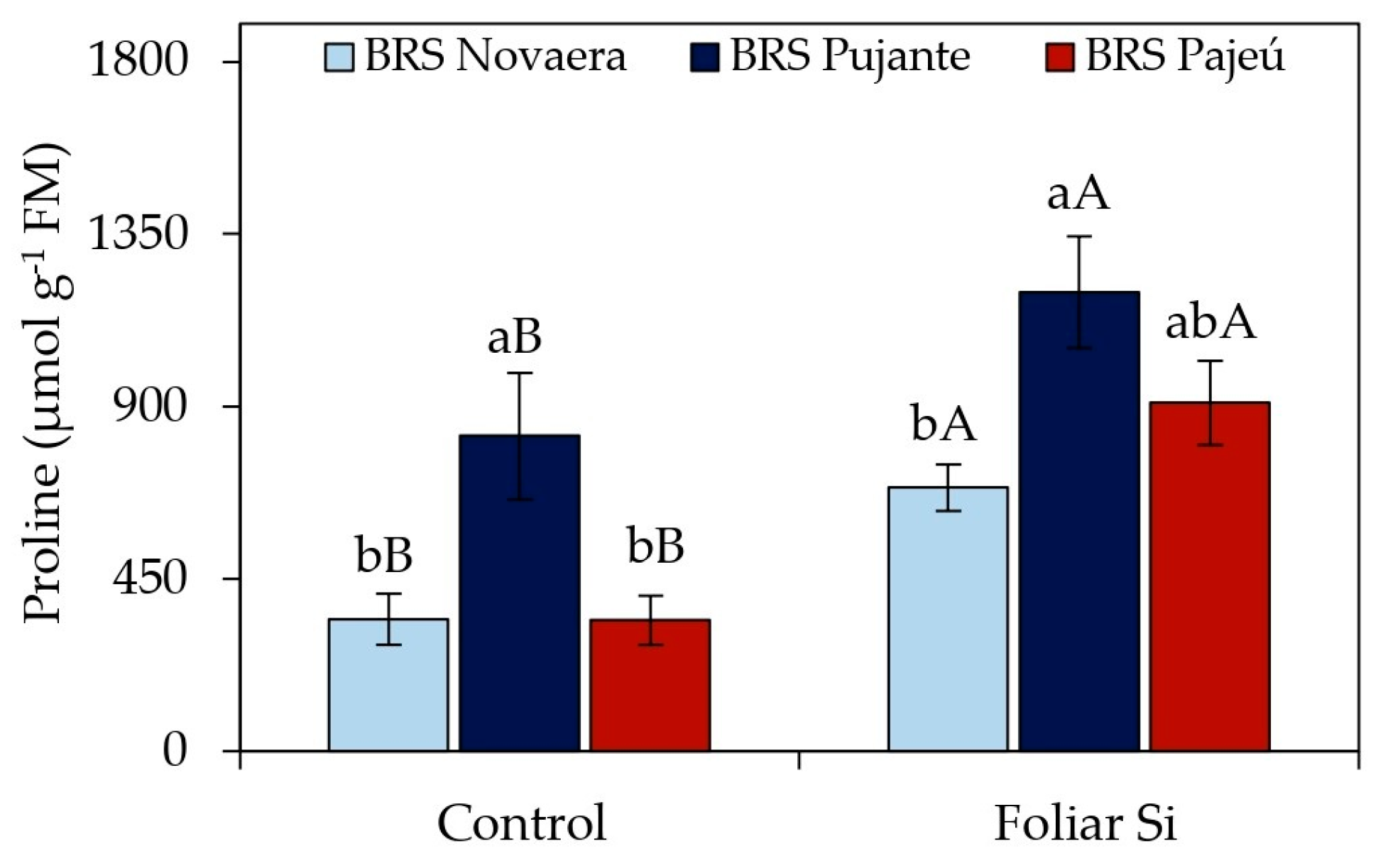

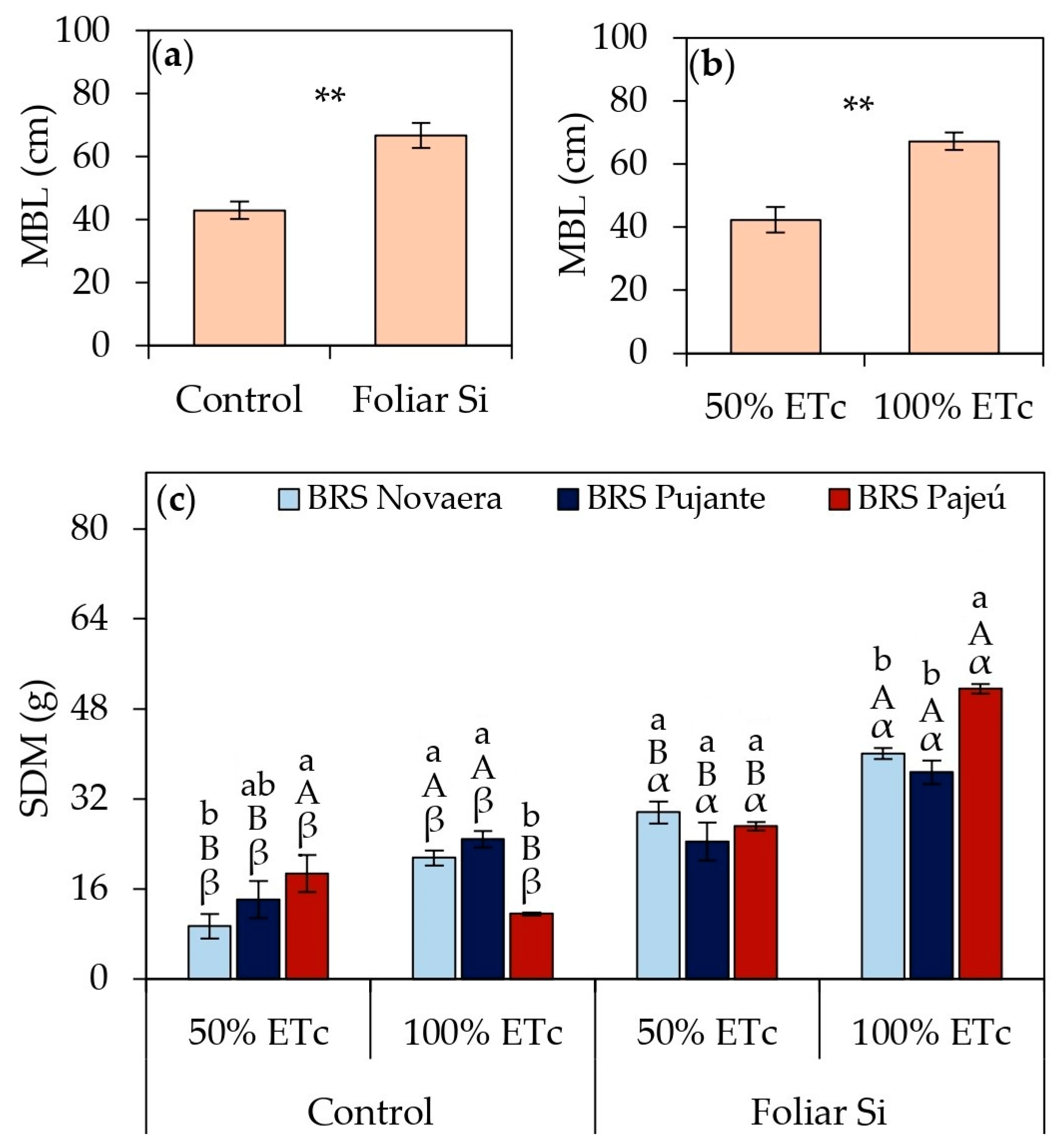
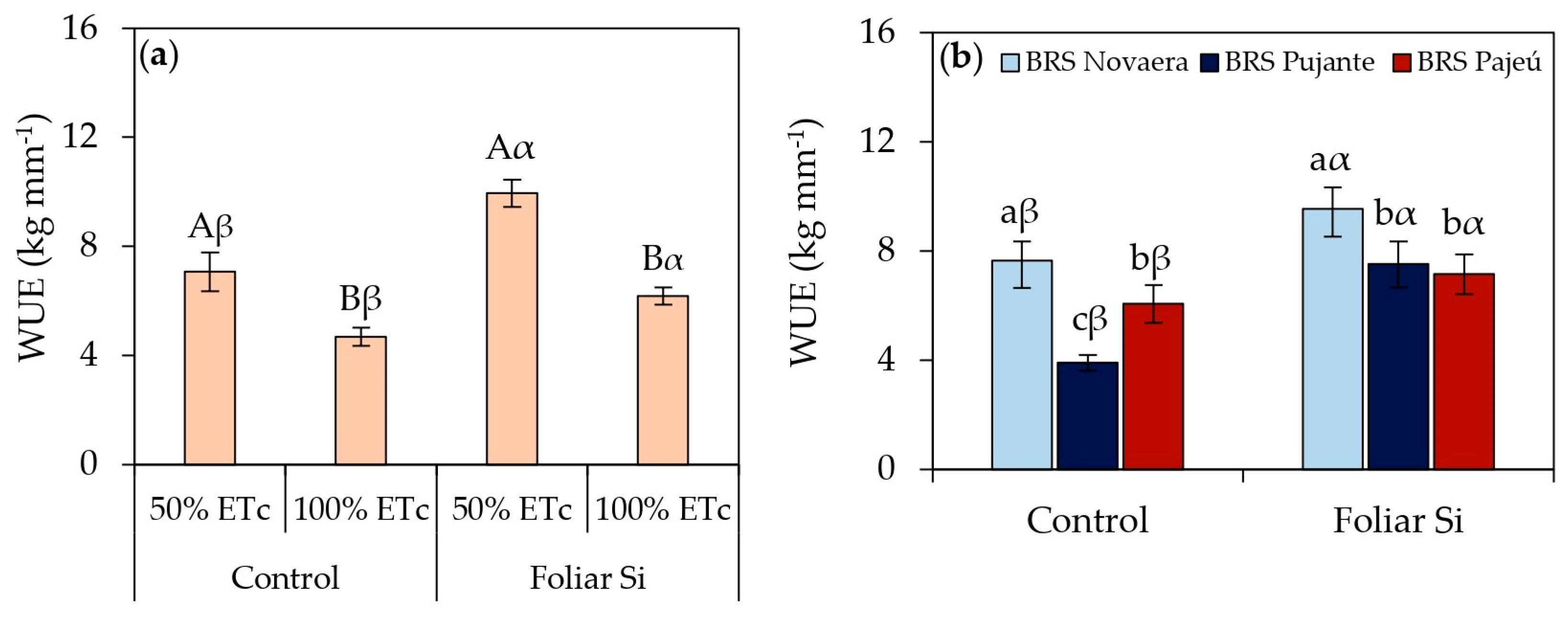
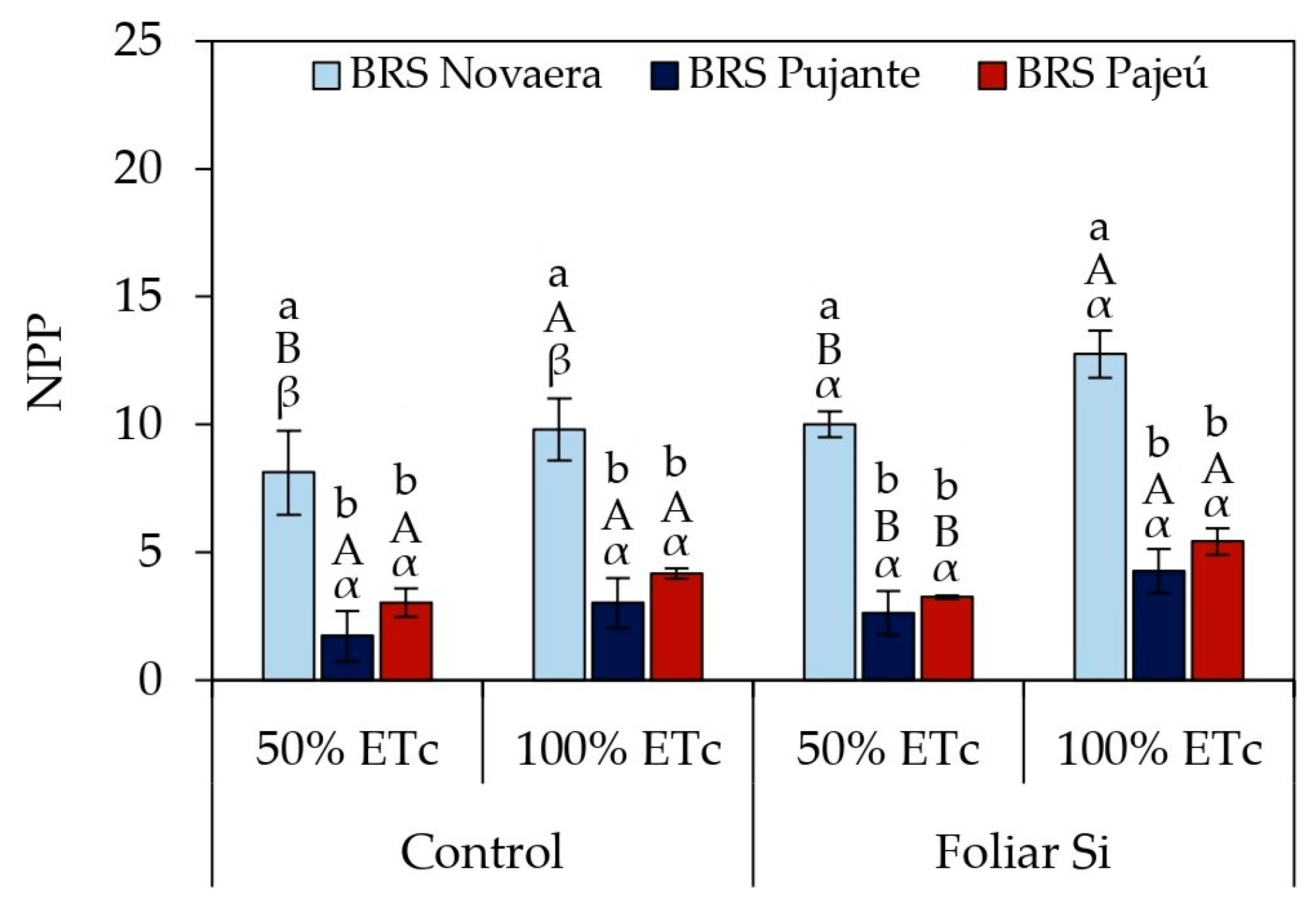

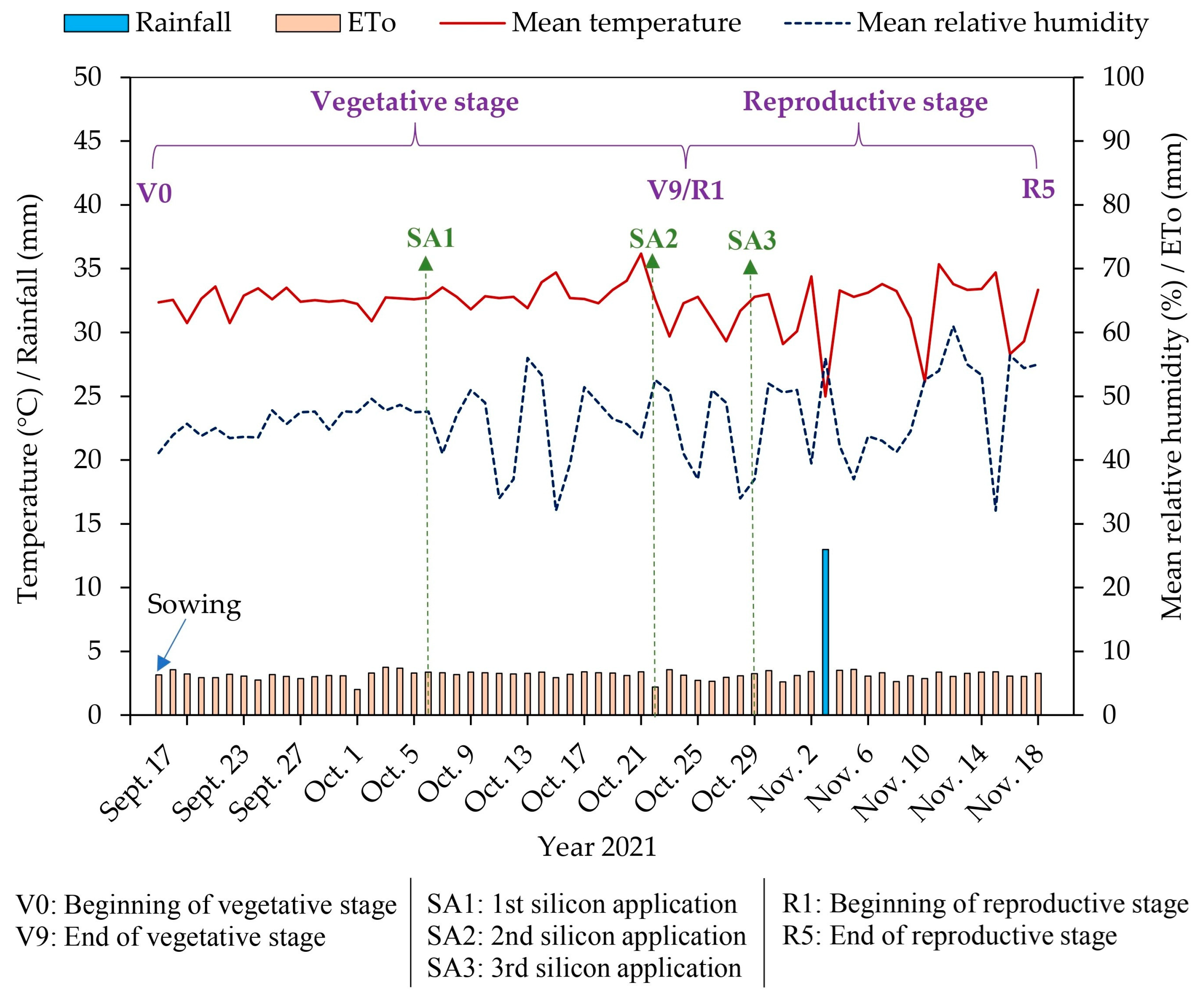
| Source of Variation | DF | Mean Square | |||||||
|---|---|---|---|---|---|---|---|---|---|
| N | P | K | Ca | Proline | SOD | CAT | APX | ||
| Block | 3 | 24.32 ns | 0.078 ns | 47.91 ns | 23.47 ns | 89,960.80 ns | 6.24 ns | 2198.51 ns | 0.09 ns |
| Irrigation depth (ID) | 1 | 6298.41 ** | 17.62 ** | 484.75 * | 291.60 * | 845,365.35 ns | 7020.90 ** | 5257.19 ns | 0.05 ns |
| Error A | 3 | 34.46 | 0.11 | 47.55 | 15.63 | 88,566.39 | 24.47 | 701.05 | 0.09 |
| Silicon (Si) | 1 | 1913.19 ** | 10.59 ** | 24.39 ns | 65.26 * | 2,205,125.63 ** | 290.96 * | 12,233.66 ** | 5.46 ** |
| Cultivar (Cul) | 2 | 1241.71 ** | 3.14 ** | 15.28 ns | 22.004 ns | 1,078,779.33 ** | 40.04 ns | 4913.51 * | 0.79 ** |
| ID × Si | 1 | 0.02 ns | 0.34 ns | 78.23 ns | 23.78 ns | 316,418.53 ns | 0.45 ns | 1029.15 ns | 1.72 ** |
| ID × Cul | 2 | 304.26 ** | 2.47 ** | 64.44 ns | 5.91 ns | 1,043,897.35 ** | 79.93 ns | 1503.52 ns | 0.62 ** |
| Si × Cul | 2 | 33.94 ns | 0.60 ns | 6.08 ns | 1.75 ns | 58,459.35 ns | 7.11 ns | 1176.37 ns | 0.08 ns |
| ID × Si × Cul | 2 | 29.72 ns | 0.25 ns | 14.96 ns | 1.51 ns | 247,645.19 ns | 55.12 ns | 622.71 ns | 0.89 ** |
| Error B | 30 | 1249.33 | 0.23 | 47.31 | 12.91 | 76,424.02 | 60.15 | 1193.64 | 0.07 |
| CV (A) (%) | - | 8.76 | 11.49 | 32.61 | 26.13 | 41.47 | 5.85 | 12.79 | 24.71 |
| CV (B) (%) | - | 9.63 | 16.57 | 32.53 | 23.75 | 38.52 | 9.17 | 16.68 | 22.49 |
| Source of Variation | DF | Mean Square | ||||
|---|---|---|---|---|---|---|
| MBL | SDM | WUE | NPP | Yield | ||
| Block | 3 | 43.05 ns | 61.51 ns | 0.98 ns | 1.31 ns | 42,760.63 ns |
| Irrigation depth (ID) | 1 | 7413.99 ** | 1318.69 ** | 113.65 ** | 38.10 ** | 3,298,685.88 * |
| Error A | 3 | 75.50 | 4.75 | 2.47 | 0.88 | 190,185.27 |
| Silicon (Si) | 1 | 6746.20 ** | 3984.53 ** | 57.64 ** | 23.98 ** | 5,140,835.70 ** |
| Cultivar (Cul) | 2 | 15.45 ns | 25.29 ns | 34.65 ** | 246.48 ** | 3,311,895.22 ** |
| ID × Si | 1 | 225.55 ns | 328.49** | 5.85 * | 2.02 ns | 1459.71 ns |
| ID × Cul | 2 | 48.63 ns | 10.21 ns | 1.86 ns | 0.60 ns | 58,972.55 ns |
| Si × Cul | 2 | 216.11 ns | 175.64 ** | 6.64 ** | 3.13 ns | 497,508.97 ** |
| ID × Si × Cul | 2 | 297.24 ns | 335.98 ** | 2.14 ns | 0.16 ns | 52,283.23 ns |
| Error B | 30 | 133.05 | 13.85 | 0.88 | 1.04 | 65,291.85 |
| CV (A) (%) | - | 15.85 | 8.44 | 22.57 | 16.57 | 20.22 |
| CV (B) (%) | - | 21.04 | 14.40 | 13.52 | 17.95 | 11.85 |
| Stages | Substages | Irrigation Depths (mm stage−1) | |
|---|---|---|---|
| 50% ETc | 100% ETc | ||
| Vegetative | V0 | 7.79 | 15.57 |
| V1 | 4.61 | 9.22 | |
| V2 | 9.57 | 19.13 | |
| V3 | 11.84 | 23.68 | |
| V4 | 9.98 | 19.97 | |
| V5 | 14.14 | 28.28 | |
| V6 | 18.11 | 36.22 | |
| V7 | 17.53 | 35.07 | |
| V8 | 17.98 | 35.95 | |
| V9 | 12.54 | 25.08 | |
| Reproductive | R1 | 15.83 | 31.66 |
| R2 | 16.84 | 33.69 | |
| R3 | 19.42 | 38.84 | |
| R4 | 18.56 | 37.13 | |
| R5 | 27.96 | 55.92 | |
| Total | 222.69 | 445.39 | |
Disclaimer/Publisher’s Note: The statements, opinions and data contained in all publications are solely those of the individual author(s) and contributor(s) and not of MDPI and/or the editor(s). MDPI and/or the editor(s) disclaim responsibility for any injury to people or property resulting from any ideas, methods, instructions or products referred to in the content. |
© 2025 by the authors. Licensee MDPI, Basel, Switzerland. This article is an open access article distributed under the terms and conditions of the Creative Commons Attribution (CC BY) license (https://creativecommons.org/licenses/by/4.0/).
Share and Cite
Queiroz, L.L.G.d.; Mesquita, E.F.d.; Sousa, C.d.S.; Pereira, R.F.; Diniz, J.P.C.; Melo, A.S.d.; Alencar, R.S.d.; Dias, G.F.; Soares, V.C.d.S.; Mesquita, F.d.O.; et al. Foliar Silicon Alleviates Water Deficit in Cowpea by Enhancing Nutrient Uptake, Proline Accumulation, and Antioxidant Activity. Plants 2025, 14, 1241. https://doi.org/10.3390/plants14081241
Queiroz LLGd, Mesquita EFd, Sousa CdS, Pereira RF, Diniz JPC, Melo ASd, Alencar RSd, Dias GF, Soares VCdS, Mesquita FdO, et al. Foliar Silicon Alleviates Water Deficit in Cowpea by Enhancing Nutrient Uptake, Proline Accumulation, and Antioxidant Activity. Plants. 2025; 14(8):1241. https://doi.org/10.3390/plants14081241
Chicago/Turabian StyleQueiroz, Larissa Lanay Germano de, Evandro Franklin de Mesquita, Caio da Silva Sousa, Rennan Fernandes Pereira, José Paulo Costa Diniz, Alberto Soares de Melo, Rayanne Silva de Alencar, Guilherme Felix Dias, Vitória Carolina da Silva Soares, Francisco de Oliveira Mesquita, and et al. 2025. "Foliar Silicon Alleviates Water Deficit in Cowpea by Enhancing Nutrient Uptake, Proline Accumulation, and Antioxidant Activity" Plants 14, no. 8: 1241. https://doi.org/10.3390/plants14081241
APA StyleQueiroz, L. L. G. d., Mesquita, E. F. d., Sousa, C. d. S., Pereira, R. F., Diniz, J. P. C., Melo, A. S. d., Alencar, R. S. d., Dias, G. F., Soares, V. C. d. S., Mesquita, F. d. O., Pires, J. P. M. M., Rodrigues, S. S., Lins, L. K. S., Alves, A. d. S., Araújo, K. T. A., & Costa Ferraz, P. d. S. (2025). Foliar Silicon Alleviates Water Deficit in Cowpea by Enhancing Nutrient Uptake, Proline Accumulation, and Antioxidant Activity. Plants, 14(8), 1241. https://doi.org/10.3390/plants14081241







